Knowledge Representation & Reasoning 知识表示与推理;共32页文档
- 格式:ppt
- 大小:370.00 KB
- 文档页数:32
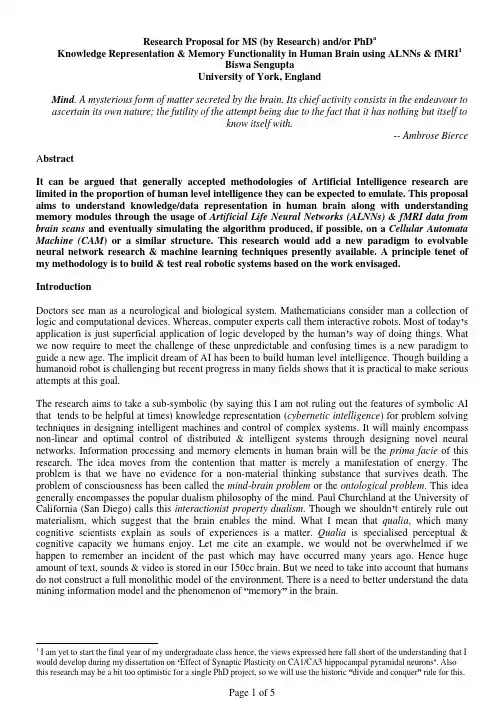
Research Proposal for MS (by Research) and/or PhD aKnowledge Representation & Memory Functionality in Human Brain using ALNNs & fMRI1Biswa SenguptaUniversity of York, EnglandMind. A mysterious form of matter secreted by the brain. Its chief activity consists in the endeavour to ascertain its own nature; the futility of the attempt being due to the fact that it has nothing but itself toknow itself with.-- Ambrose Bierce A bstractIt can be argued that generally accepted methodologies of Artificial Intelligence research are limited in the proportion of human level intelligence they can be expected to emulate. This proposal aims to understand knowledge/data representation in human brain along with understanding memory modules through the usage of Artificial Life Neural Networks (ALNNs) & fMRI data from brain scans and eventually simulating the algorithm produced, if possible, on a Cellular Automata Machine (CAM) or a similar structure. This research would add a new paradigm to evolvable neural network research & machine learning techniques presently available. A principle tenet of my methodology is to build & test real robotic systems based on the work envisaged.IntroductionDoctors see man as a neurological and biological system. Mathematicians consider man a collection of logic and computational devices. Whereas, computer experts call them interactive robots. Most of today s application is just superficial application of logic developed by the human s way of doing things. What we now require to meet the challenge of these unpredictable and confusing times is a new paradigm to guide a new age. The implicit dream of AI has been to build human level intelligence. Though building a humanoid robot is challenging but recent progress in many fields shows that it is practical to make serious attempts at this goal.The research aims to take a sub-symbolic (by saying this I am not ruling out the features of symbolic AI that tends to be helpful at times) knowledge representation (cybernetic intelligence) for problem solving techniques in designing intelligent machines and control of complex systems. It will mainly encompass non-linear and optimal control of distributed & intelligent systems through designing novel neural networks. Information processing and memory elements in human brain will be the prima facie of this research. The idea moves from the contention that matter is merely a manifestation of energy. The problem is that we have no evidence for a non-material thinking substance that survives death. The problem of consciousness has been called the mind-brain problem or the ontological problem. This idea generally encompasses the popular dualism philosophy of the mind. Paul Churchland at the University of California (San Diego) calls this interactionist property dualism. Though we shouldn t entirely rule out materialism, which suggest that the brain enables the mind. What I mean that qualia, which many cognitive scientists explain as souls of experiences is a matter. Qualia is specialised perceptual & cognitive capacity we humans enjoy. Let me cite an example, we would not be overwhelmed if we happen to remember an incident of the past which may have occurred many years ago. Hence huge amount of text, sounds & video is stored in our 150cc brain. But we need to take into account that humans do not construct a full monolithic model of the environment. There is a need to better understand the data mining information model and the phenomenon of memory in the brain.1 I am yet to start the final year of my undergraduate class hence, the views expressed here fall short of the understanding that I would develop during my dissertation on Effect of Synaptic Plasticity on CA1/CA3 hippocampal pyramidal neurons. Also this research may be a bit too optimistic for a single PhD project, so we will use the historic divide and conquer rule for this.Problem Statement & Research QuestionsThe question is Can we emulate this on the neural network structures? Perhaps not. This is where Artificial Life Neural Networks (ALNNs) become useful. They live in physical networks or in other words they are ecological networks. In ALNNs, the physical environment assigns semantics to the output of the nervous system. The behaviour of ALNNs is the result of the output of the network itself, the environment, and of their interactions. I am deeply engrossed with the thought of using ALNN in an effort to understand data representation and memory in human brain. It would be fascinating to know that the input of an ALNN primarily encodes the state of the local physical environment around the organism. There the physical environment would be of par importance in assigning a semantic to the activation pattern of the input and the output of the neural network. Eventually, ALNNs may acquire through evolution an ability to extract from the environment, reinforcement learning signals or auto-generated teaching inputs and use them to adapt to the environment during their lifetime. Most ANN models are far from the biological reality; modelling neurons and synapses and developing computational tolls able to perform efficiently in perceptive tasks are different businesses despite a common inspiration.I envisage implementing the outcome and understanding of this research, if possible in the form of an algorithm on a cellular automata machine (CAM), which presently would be a RAM based lookup table hardware device [Toffoli & Margolus 1990], using Evolutionary & Genetic Algorithms.This research would add an insight to other research that aims to understand the human brain in greater depth thus implementing the mind electronically. It will add to our existing knowledge in making clever robots & add to the present family of robots like MIT s COG & KISMET (though Minsky explains that the researchers are not very candid about the limitations of the performance of their systems) and Sony s Aibo. Such an artificial nervous system will be too complex to be humanly designable, but it may be possible to evolve it, and incrementally, by adding neural modules to an already functional artificial nervous system.Theoretical and experimental researches have a reciprocal relationship theories suggest experiments, while experiments confirm or disconfirm theories and suggest new bases for theories. Second, the data that has already been collected clearly demonstrates to an impartial observer that the phenomenon exists, so as far as the idea is concerned looking for further proof of existence is sterile. As the rising flood reaches more populated heights, machines will begin to do well in areas a greater number can appreciate. The visceral sense of a thinking presence in machinery will become increasingly widespread. The presence of minds in machines will then become self-evident.I plan to decipher knowledge representation in brain using the already available information on layering, hyper-columnarisation, neurochemical modulation, splitting neurons, retina/LGN, thalamus & V1, early associate visual cortex, temporal lobe/hypothalamus, hippocampus (for memory representation), etc. If time permits I foresee a need of constructing multi-module expansion for ALNN with automatic training. Over time, artificial nervous systems should grow in complexity, until they can be called emotional machines. An alternative approach of using a CAM is to use Eldridge and Hutchings run-time reconfigurable (FPGA) hardware system (RRANN) to execute a back-propagation learning algorithm in a feed-forward neural network.Review of Related ResearchThis research is certain to revolutionize the field of neural networks and artificial life, because it will provide a powerful new tool to evolve artificial brains with billions of neurons, and at electronic speeds. This will help to produce the Darwin Machine, i.e. a machine that evolves its own architecture. To the best of my knowledge, I wouldn t deny that similar research is going in different labs across the world but MIT s Media Lab & the AI Lab (especially the Living Machines group) require a special mention. The second is in Switzerland at the EPFL under Eduardo Sanchez & Prof. Dario Floreano. Belgium s Lernout & Hauspie (L&H) is using a CAM for speech processing feasibility studies. Several scientists acrossBelgium, Japan, Poland, China & the US are known to have been looking on related aspects of this research. I think at some point in time, I have to visit the Delayed Pointer Neural Net (DePo NN) based on Collect & Distribute Neural Net (CoDi) model & the electronic Learning Evolutionary Model (eLEM)along with Prof. Tom Mitchellimages. Terry Sejnowski at Salk Institute, has done a lot of work from modelling the hippocampus, to face recognition to speech recognition to motion perception, the latest being independent component analysis & temporal hebbian learning.Deliverable and Program Schedule (Course of Action)I have had this ambition to understand the brain since I was a grade 8 student. My undergraduate degree in Electronics & Computer Engineering would have an impetus to my attained knowledge on belief networks in dynamic systems. I am confident that my understanding of cognition modules through a signalling point of view in my undergraduate dissertation will help me to develop the relevant models for data (as an abstract of feelings) & memory in human brain. I plan to complete the first phase of my research i.e., to develop an algorithm to mimic this representation by the end of my MS & then I would like to continue implementing the outcome of my research in due course of my PhD. This will allow researchers involved with decision-making & machine learning to better understand the state space on which the former is implemented, constrained by completely noisy, constantly changing environment. Research Design, Methodology & ApproachFigure 1 Proposed model for the researchI plan to use fMRI (functional Magnetic Resonance Imaging) data with a machine learning perspective for my research. An fMRI plot produces time-series data that represent brain activity in a collection of 2D slices of the brain. Multiple 2D slices can be captured, forming a 3D image that may contain on the order of 15,000 voxels. The resulting fMRI time series thus provides us with a high resolution 3D movie of the activation across a large fraction of the brain. This would be done by automatically classifying the instantaneous cognitive state of a human being, given his/her observed fMRI activity at a single time instant or time interval. But I see some problems like cognitive activity can change within 20 milliseconds, while a single 3D scan commonly takes 3 seconds, by which point dozens if not hundreds of different cognitive events could have occurred. This problem is compounded by the activation in a timepoint having been caused by a neurophysiologic event around 8 seconds earlier (since blood oxygen levels what fMRI actually records take this long to build up). Second of all, given that the human brain is parallel, and given that we are incredibly complex in our thinking patterns, the exact same task could be carried out ( in terms of cognitive states at least) quite differently on different occasions within subjects and between subjects, even if performance is identical. Keeping these perils in mind, I would use classifiers like Gaussian naïve Bayes (GNB) as a tool for decoding and tracking the sequence of hidden cognitive states of a subject. A large success of this research relies on machine learning algorithms that can successfully learn the spatial-temporal fMRI patterns that distinguish these cognitive states.For this we should clarify our understanding of how the brain and nerves actually generate thought and language. We understand the brain at the low level, the individual neurons, and we also have the capability to understand the high level, in the sense of which part lights up when I am writing this proposal. I am aware of the limitations that can arise when trying to emulate complex thought processes but am optimistic on my capabilities.Though I have mentioned my view, to implement the algorithm on a CAM, I am pretty unsure if this becomes a non-result oriented method in the future. I plan to switch to other methodology if this approach looks pessimistic. I have concluded that this research is interesting and ambitious, but in so far as it is a life-long project (maybe several life-times) I think I need to make it even more ambitious, for the simple reason that the system I am trying to understand has many levels of abstraction and I don t think any of them can be fully understood without the others. BUT one doesn t have to understand all levels equally well, and for some questions one can ignore the lowest levels. Likewise, biological evolution evolved designs at different levels of abstraction. They co-evolved. Some aspects of the higher-level machines are implementation independent and some implementation dependent. So, it would be a good idea to understand the highest level of cognitive function first.I agree with what Piaget discovered that for example the architecture of the mind of a 3 year old child is very different from that of a typical adult, and may be even adult architectures can vary, depending on the culture, personal development trajectories, trauma, etc.The proposed research can be outlined as in Figure 1. The basic questions that I wish to explore are: How the human brain stores experiences of past events by diving them into fragments?How neuro-transmitters help the process (using perhaps action-potential)?When presented with relevant information, how does the brain co-relate the input i.e., the essential link between vision & audio to match that information?What sort of an algorithm that can mimic this behaviour? Hence I am basically heading towards brain-based knowledge representation architecture.I am still building up other perspectives not limiting only to levels that are relatively close to brain structure. For this I am learning and reading on Central Nervous System as neuroscience has been developing rapidly over the last 25 years. I am making an effort to understand the organization of the real nervous system, and, along with that, the organization of behaviours as seen in the field of ethology, where there are interesting studies of behavioural evolution which is fundamental to understanding brain evolution. Also at present, my time is adsorbed on maximum likelihood, information theory & expectation maximization (esp. Baum s algorithm) apart from enlightening myself with probability theory, pattern recognition and signal processing.Constructing a mind is simply a different kind of problem of how we can synthesise organizational systems that can support a large enough diversity of different schemes, yet enable them to work together to exploit one another s abilities. I gaze to the question of self-organization, whether some processes can dissipate energy (computer cycles) and locally reverse entropy (get more & more complex). In other words, what kind of system can eventually produce a brain, rather than what is the brain.I will not rule out the fact that I might come across techniques that may change my angle of attack towards the problem and help in formation of a robust algorithm. I presume that my multitude encounters with hardcore research in the British Aerospace DCSC lab in the form of developing scenario based assessment (for software reliability) to produce an algorithm using neural network & genetic algorithms, will help my capability as a prospective researcher. The work here developed my critical understanding of search space. Especially, my knowledge on meta-heuristic search along with reliability perspective of software using Markov Analysis, Queuing Networks, Stochastic Petri Nets (SPN), etc to name a few have been greatly enlightened here. I have also thought of taking an initiative to develop parallel search spaces, but it needs a bit more thought.I am indebted to Marvin Minsky (co-founder MIT AI Labs), Aaron Sloman (University of Birmingham), Gerald E. Schneider (MIT Brain & Cognitive Science) & Jordan Pollack (Brandeis) for increasing my productivity by their useful inputs during the writing of this research proposal.References1.Parisi D., Cecconi F., and Nolfi S. (1990), Econets: Neural networks that learn in an environment.Network, 1: 149-1682.Harnard S. (1990), Symbol grounding problem. Physica D, 42: 335-4643.Ackley D.E., and Littman M.L. (1991), Interaction between learning and evolution. In C.G. Langton et.al(Eds) Proceedings of the second conference on Artificial Life. Addison-Wesley: Reading, MA4.Nolfi S, Parisi D. (1993), Auto-teaching networks that develop their own teaching input, In J.L.Deneubourg, H. Bersini, S. Goss, G. Nicholis, R. Dagonnier (Eds), Proceedings of the second European Conference on Artificial Life, Brussels, Free University of Brussels5.Nolfi S, Parisi D., Neural Networks in an Artificial Life Perspective6.Brooks R.A., Prospects for Human Level Intelligence for Humanoid Robots7.Garis Hugo de, CAM-Brain The evolutionary Engineering of a Billion Neuron Artificial Brain by 2001which Grows/Evolves at Electronic speeds inside a cellular Automata Machine (CAM)8.Gazzaniga Michael S. et al., Cognitive Neuroscience The Biology of the mind9.Nichols John G. et al., From Neuron to Brain10.Mc Clelland James L, Understanding the Mind by simulating the Brain11.Korkin M and de Garis H, The CAM Brian Machine (CBM) An FPGA based hardware Tool that evolvesa 1000 neuron-net circuit module in seconds and updates a 75 million neuron artificial brain for real-timerobot control12.Dinerstein J, Dinerstein N and de Garis H, Automatic Multi-module neural network evolution in anartificial brain13.Brooks R.A, Breazeal C, Robert I, Kemp C.C, Marjanovic M, Scassellati B, Williamson M.M, AlternativeEssences of Intelligence14.Yao X, Evolving Artificial Neural Networks15.Mitchell Tom M. et al, Classifying Instantaneous Cognitive States from fMRI Data16.Minsky M. (1987), The Society of Mind, Simon and Schuster17.Minsky M., Logical vs. Analogical OR Symbolic vs. Connectionist OR Neat vs. Scruffy18.Verleysen M., The explanatory power of Artificial Neural Networksa For the latest version of the proposal please refer to http:// /~bs125 [Revision 2.1]。

知识的表征:总结我们每天都会通过眼睛和耳朵以及其他感觉器官,收集大量的信息。
虽然大部分信息我们都记不住,但就算是能记住的那些,也并不是全都会被看作知识。
每个人都曾在学校里学习过大量知识。
我们每天也会自学大量的知识。
所以,关于知识,人人都是业余的心理学家。
每个人都或多或少地了解人类是如何理解、学习、表达和运用知识的。
这周,我们已经读了《认知心理学及其启示》的第五章,知识的表征。
现在,我们对于知识的认识,应该会更加专业了。
先来看这个章节的结构:5.知识的表征(Representation of Knowledge)5.1.知识及相关脑区5.2.对事件意义的记忆5.2.1.言语信息的记忆5.2.2.视觉信息的记忆5.2.3.有意义的解读很重要5.2.3.1.细节与意义的保持5.2.3.2.有意义的记忆效果好的启示启示专栏:用来记住词汇的记忆技术5.3.命题表征5.4.通道无关符号系统与知觉符号系统(Amodal Versus Perceptual Symbol Systems)5.5.具身认知5.6.概念化的知识5.6.1.语义网络5.6.2.图式5.6.2.1.图式的心理学真实性5.6.2.2.类别成员的隶属程度5.6.2.3.事件概念5.6.3.原型理论和实例理论5.6.4.基于规则的类别和基于理论的类别5.6.5.自然类别和它们在脑中的表征5.6.结论再来看作者提出的开篇:1.我们如何表征自身经验中那些很重要的方面?2.我们能在不限定于特定知觉通道的情况下,表征知识吗?3.我们如何表征类别知识?它如何影响我们看待世界的方式?接下来,让我们一节节来回顾这个章节的内容。
5.2.1这一节,从Wanner的实验可以看出,人们通常并不能记住别人在说话时具体用了哪些词语,但能记住别人说的那番话的意义。
这个实验并不令人意外。
大家都有很多切身体会。
我们能复述别人说的话的大概意思,但很难一字不差地复述别人说的话。
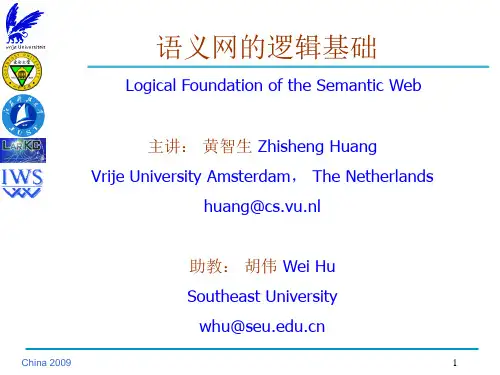

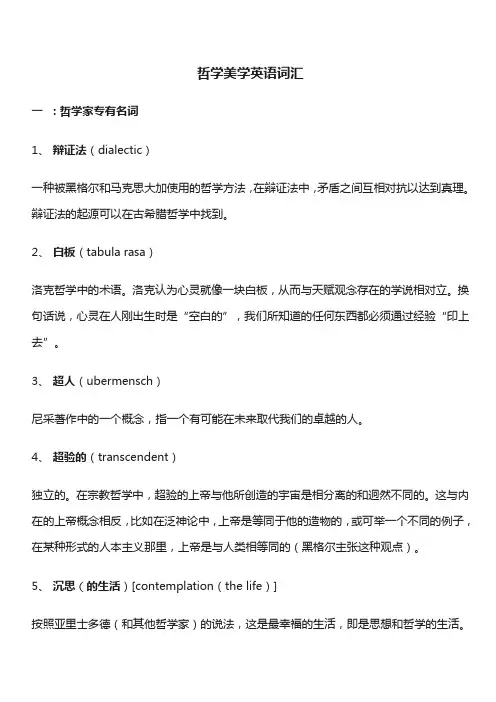
哲学美学英语词汇一:哲学家专有名词1、辩证法(dialectic)一种被黑格尔和马克思大加使用的哲学方法,在辩证法中,矛盾之间互相对抗以达到真理。
辩证法的起源可以在古希腊哲学中找到。
2、白板(tabula rasa)洛克哲学中的术语。
洛克认为心灵就像一块白板,从而与天赋观念存在的学说相对立。
换句话说,心灵在人刚出生时是“空白的”,我们所知道的任何东西都必须通过经验“印上去”。
3、超人(ubermensch)尼采著作中的一个概念,指一个有可能在未来取代我们的卓越的人。
4、超验的(transcendent)独立的。
在宗教哲学中,超验的上帝与他所创造的宇宙是相分离的和迥然不同的。
这与内在的上帝概念相反,比如在泛神论中,上帝是等同于他的造物的,或可举一个不同的例子,在某种形式的人本主义那里,上帝是与人类相等同的(黑格尔主张这种观点)。
5、沉思(的生活)[contemplation(the life)]按照亚里士多德(和其他哲学家)的说法,这是最幸福的生活,即是思想和哲学的生活。
6、存在的世界(world of Being)柏拉图形而上学中的术语,指理想中的“形式”的世界,这个世界是没有变化的,我们只能通过理性和思想来认识这个世界。
7、单子(monad)莱布尼茨用来指一切不变事物的最终组成部分的非物质实体,上帝是唯一一个不是被创造的单子,他作为自我封闭的(“无窗的”)的先定实体创造了所有其他单子。
8、狄奥尼索斯式的(尼采)[Dionysian(Nietzsche)]艺术、精力和意志中的非理性原则。
9、公意(卢梭)[general will(Rousseau)]一个民族集体的愿望和决定。
10、信仰的飞跃(leap of faith)克尔凯郭尔的用语。
他认为一个人不可能证明他所信仰的东西。
11、海森堡不确定性原理(物理学中的)[Heisenberg uncertainty principle(in physics)]一个亚原子粒子的运动和位置不可能同时确定。
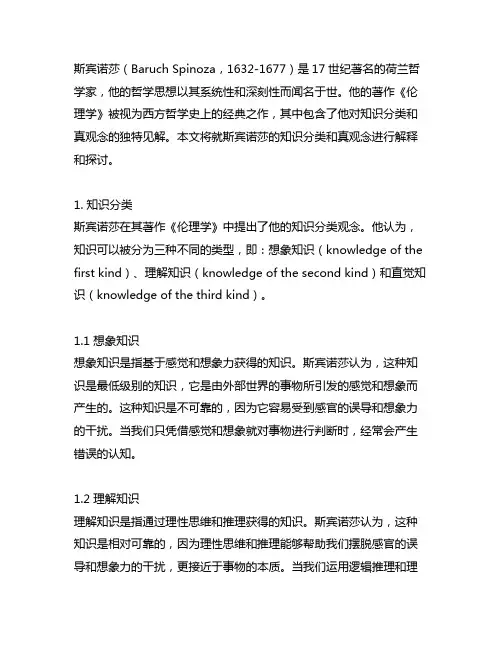
斯宾诺莎(Baruch Spinoza,1632-1677)是17世纪著名的荷兰哲学家,他的哲学思想以其系统性和深刻性而闻名于世。
他的著作《伦理学》被视为西方哲学史上的经典之作,其中包含了他对知识分类和真观念的独特见解。
本文将就斯宾诺莎的知识分类和真观念进行解释和探讨。
1. 知识分类斯宾诺莎在其著作《伦理学》中提出了他的知识分类观念。
他认为,知识可以被分为三种不同的类型,即:想象知识(knowledge of the first kind)、理解知识(knowledge of the second kind)和直觉知识(knowledge of the third kind)。
1.1 想象知识想象知识是指基于感觉和想象力获得的知识。
斯宾诺莎认为,这种知识是最低级别的知识,它是由外部世界的事物所引发的感觉和想象而产生的。
这种知识是不可靠的,因为它容易受到感官的误导和想象力的干扰。
当我们只凭借感觉和想象就对事物进行判断时,经常会产生错误的认知。
1.2 理解知识理解知识是指通过理性思维和推理获得的知识。
斯宾诺莎认为,这种知识是相对可靠的,因为理性思维和推理能够帮助我们摆脱感官的误导和想象力的干扰,更接近于事物的本质。
当我们运用逻辑推理和理性分析来认识事物时,就能避免想象知识的错误和偏见,获得更为准确和深刻的认知。
1.3 直觉知识直觉知识是指通过直接洞察和内心体验获得的知识。
斯宾诺莎认为,这种知识是最高级别的知识,它能够帮助我们超越理性思维和推理,直接认识事物的本质和内在通联。
当我们通过灵感和直觉来洞察事物的本质时,就能获得更为深刻和全面的认知。
2. 真观念斯宾诺莎在其著作《伦理学》中提出了他的真观念理论。
他认为,真观念是指反映事物本质的认知观念,它是用理性思维和直觉洞察获得的,能够帮助我们认识事物的本质和内在通联,是最为可靠和深刻的认知。
2.1 真观念的特征斯宾诺莎认为,真观念具有以下几个特征:2.1.1 真理性真观念是反映事物本质的认知观念,它具有真实性和客观性,能够指导我们正确地认识和理解事物。

简述知识的表征
知识的表征是指将知识以某种形式展现出来,使得人们能够理解和应用这些知识。
在计算机科学领域,知识的表征是人工智能和机器学习的重要研究方向之一。
以下将介绍几种常见的知识表征方法,并进行拓展。
1. 符号逻辑:符号逻辑是一种基于逻辑推理和符号运算的知识表征方法。
它将知识表示为一组逻辑命题和规则,使用符号来表示对象、关系和操作,通过逻辑推理来推导新的知识。
符号逻辑的优势在于它能够进行精确的推理和推导,但它对知识的表示和推理的复杂性有一定的限制。
2. 语义网络:语义网络是一种使用节点和边表示对象和关系的知识表征方法。
节点表示实体或概念,边表示它们之间的关系。
通过构建语义网络,可以将知识以图形方式展示出来,便于人们理解和推理。
语义网络的优势在于它能够灵活地表示复杂的关系和知识结构,但它对知识的表示和推理的效率有一定的挑战。
3. 本体论:本体论是一种基于语义的知识表征方法,它将知识表示为一组概念和关系的层次结构。
本体是一种形式化的规范,定义了概念之间的关系和属性。
通过使用本体,可以将知识以一种结构化和一致的方式进行表达,便于知识的共享和集成。
本体论的优势在于它能够提供一种统一的知识表示和推理框架,但它对知识的建模和维护的复杂度较高。
除了以上几种常见的知识表征方法,还有一些其他的方法,如神经网络、贝叶斯
网络等。
这些方法在知识表征方面有着各自的优势和应用场景。
此外,随着深度学习和自然语言处理等技术的发展,知识表征也得到了更多的关注和研究。
未来,我们可以期待更加高效和智能的知识表征方法的出现,以进一步提升人工智能和机器学习的能力。
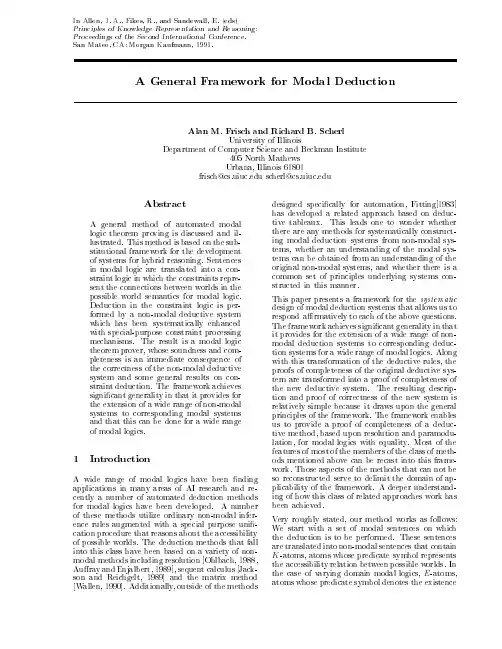

知识表示(knowledge representation)是指把知识客体中的知识因子与知识关联起来,便于人们识别和理解知识。
知识表示是知识组织的前提和基础,任何知识组织方法都是要建立在知识表示的基础上。
知识表示有主观知识表示和客观知识表示两种。
结构知识的表示就是对知识的一种描述,或者说是对知识的一组约定,一种计算机可以接受的用于描述知识的数据结构。
某种意义上讲,表示可视为数据结构及其处理机制的综合:表示= 数据结构+处理机制。
因此在ES中知识表示是ES 中能够完成对专家的知识进行计算机处理的一系列技术手段。
常见的有产生式规则、语义网、框架法等。
方法经过国内外学者的共同努力,已经有许多知识表示方法得到了深入的研究,使用较多的知识表示方法主要有以下几种知识表示方法。
(1)逻辑表示法逻辑表示法以谓词形式来表示动作的主体、客体,是一种叙述性知识表示方法。
利用逻辑公式,人们能描述对象、性质、状况和关系。
它主要用于自动定理的证明。
逻辑表示法主要分为命题逻辑和谓词逻辑。
逻辑表示研究的是假设与结论之间的蕴涵关系,即用逻辑方法推理的规律。
它可以看成自然语言的一种简化形式,由于它精确、无二义性,容易为计算机理解和操作,同时又与自然语言相似。
命题逻辑是数理逻辑的一种,数理逻辑是用形式化语言(逻辑符号语言)进行精确(没有歧义)的描述,用数学的方式进行研究。
我们最熟悉的是数学中的设未知数表示。
例:用命题逻辑表示下列知识:如果a 是偶数,那么a2 是偶数。
解:定义命题如下:P:a 是偶数;Q: a2 是偶数,则:原知识表示为:P→Q 谓词逻辑相当于数学中的函数表示。
例:用谓词逻辑表示知识:自然数都是大于等于零的整数解:定义谓词如下:N(x):x 是自然数;I(x):x 是整数;GZ(x):x 是大于等于零的数。
所以原知识表示为:(∀x)(N(x)(GZ(x)∧I(x)),∀(x)是全称量词。
(2)产生式表示法产生式表示,又称规则表示,有的时候被称为IF-THEN 表示,它表示一种条件-结果形式,是一种比较简单表示知识的方法。
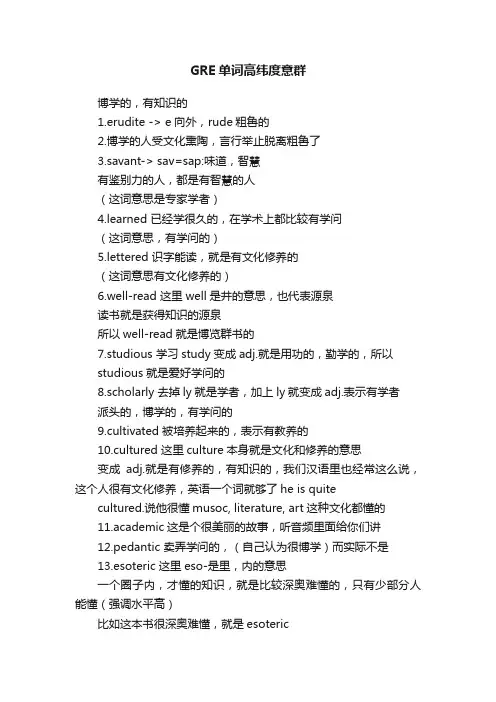
GRE单词高纬度意群博学的,有知识的1.erudite -> e向外,rude粗鲁的2.博学的人受文化熏陶,言行举止脱离粗鲁了3.savant-> sav=sap:味道,智慧有鉴别力的人,都是有智慧的人(这词意思是专家学者)4.learned 已经学很久的,在学术上都比较有学问(这词意思,有学问的)5.lettered 识字能读,就是有文化修养的(这词意思有文化修养的)6.well-read 这里well是井的意思,也代表源泉读书就是获得知识的源泉所以well-read就是博览群书的7.studious 学习study变成adj.就是用功的,勤学的,所以studious就是爱好学问的8.scholarly 去掉ly就是学者,加上ly就变成adj.表示有学者派头的,博学的,有学问的9.cultivated被培养起来的,表示有教养的10.cultured 这里culture本身就是文化和修养的意思变成adj.就是有修养的,有知识的,我们汉语里也经常这么说,这个人很有文化修养,英语一个词就够了he is quitecultured.说他很懂musoc, literature, art这种文化都懂的11.academic这是个很美丽的故事,听音频里面给你们讲12.pedantic 卖弄学问的,(自己认为很博学)而实际不是13.esoteric 这里eso-是里,内的意思一个圈子内,才懂的知识,就是比较深奥难懂的,只有少部分人能懂(强调水平高)比如这本书很深奥难懂,就是esoteric14.recondite 这里re-是一再的意思cond是藏的意思一再被藏起来的知识->深奥的谦逊的,卑微的15.meek 温顺的比如温顺的羊meek sheep16.obsequious 里ob是朝,向;sequ是sequence,follow的意思加到一起就是:跟班根本的人什么样子:奉承!拍马屁!顺从!所以,obsequious就是谄媚的,顺从的17.unobtrusive这里un是不,obtrusive:冒失的ob是朝,向trus= push推: 推到外面,就是冒失的unobtrusive不冒失的=低调的!18.humble19.lowly是形容词,low地,lowly地位低的=谦卑的20.base 地位低的=卑劣的21.ignominious 这里ig是不,nomin是名誉连名誉都不要了=可耻的22.bashful 这里bash是用力打击....被用力打击之后,就很没自信,很尴尬,也很shy23.diffidence 的反义词是confidence24.abase 这里a朝,向base,低abase就是使地位降低=使谦卑25.demean 这里de使,mean卑劣的,使卑鄙=贬低26.debase27.degrade 这里grade层级,降低层级28.unassuming 这里assume有假设的意思,还有装腔作势的意思,不装腔作势的=谦逊的29.mortified 难为情shyMors是死神,一个穿黑袍,拿镰刀,很阴森的老人30.ignoble 这里ig不,noble是贵族的,不是贵族的=卑鄙的,可耻的noble最为贵族的,不是那种近亲结婚保守的蓝血贵族,是那种通过努力也可以进入到上层社会的贵族哦煽动,激发,促进31.foment fom火>使燃烧>煽动32.foster33.ignite 点燃34.facilitate facil>使简化>促进35.prob 刺>鼓动36. 6.agitate ag>做37.permit38.catalyze 催化>促进39.vitalize vital生命40.impel in内pel 推41.abet a去bet咬42.precipitate pre 之前cip头43.aid44.incubate in里cub躺45.spur 马刺46.patronize patron艺术赞助商,保护人,老主顾47.unobstructed un没有obstruct阻挡48.goad 刺牛棒49.startle start吃惊50.instigate sting刺51.roil泥土粪土52.incite in里cite召唤53.whip 鞭子54.whipping boy 替罪羊联合,混合55.concatenate 锁链般连接56.intersection 十字路口->连接处57.meld = melt+ weld/doc/d258a267fbd6195f312b3169a451772 32e60e47b.html pound 混合59.amalgamate 汞合金->点石成金60.consolidate61.coalesce 汇集62.aggregate 聚集total63.adhere64.converge65.nexus 错综复杂承上启下66.uncleate67.solder 焊接联接68.assemble69.blend70.mingle71.bind72.cement73.fuse74.bracket75.coagulate 凝结76.miscible 能混合的77.affiliate 有故事的单词最高点78.zenith79.Topmost80.Summit81.acme82.pinnacle83.climax84.7.. culmination抨击85.denounce这里de是坏,nounce是喊喊坏的事情,就是抨击86.aspersion 这里asper词根是说的意思这词还有洒水的意思,往人身上泼脏水,也是抨击、责难,损坏别人声誉87.diatribe 这里dia是穿过,tribe是摩擦说话发生摩擦,批评,攻击88.rail火车轨道,动词有责骂、抱怨的意思89.vituperate 责难/doc/d258a267fbd6195f312b3169a451772 32e60e47b.html mbase91.censure 同根词census是古罗马人口普查,那个时候普查不仅仅查人数,更主要的是根据财富能力数量来进行社会评级,以此来设置政治权利,比如管辖区域大小之类,听起来还蛮科学。

哲学词典 representation引言在哲学中,representation(代表,表象)是一个重要的概念。
它是指事物被某种形式所表征或呈现的过程。
本文将从不同的角度探讨representation的含义、作用和影响。
表象的本质表象可以理解为对现实世界的再现或呈现,它可以是语言、符号、图像、音乐、艺术作品等形式。
表象具有代表性,通过符号化的方式将事物传达给人类。
语言的表象语言是一种最常见的表象形式,它通过词汇和语法的组合,将思想转化为可被理解和传递的形式。
语言的表象具有传递信息、描述事物和表达意义的功能,是人类交流和思考的基础。
符号的表象符号是一种抽象的表象形式,它通过符号与所代表事物之间的关系,将抽象的概念转化为可感知的形式。
符号可以是文字、数字、图形等,它们在不同的文化和领域中具有不同的含义和符号化规则。
艺术的表象艺术作为一种表达形式,通过绘画、雕塑、音乐、舞蹈等媒介,将创作者的内在感受和思想通过形式化的方式传达给观众。
艺术作品是一种特殊的表象形式,它具有创造性、观念性和审美性。
表象的作用表象在人类社会中起着重要的作用,它影响我们的思维、认知和行为。
信息传递表象是一种信息的传递媒介,它通过符号和符号之间的组合和关系,将复杂的概念和事物转化为可理解和传递的形式。
表象在交流、教育、传媒和科学研究中起着重要的作用,使人们能够共享知识和经验。
认知建构表象对认知的形成和建构有着重要影响。
人们通过接收和处理表象,构建自己对世界的认知模型。
不同的表象形式和符号化规则会影响人们对事物的理解和解释,进而影响行为和决策。
文化传承表象是文化的载体,它通过语言、艺术、宗教等形式,传承和保持文化的特征和价值观。
不同的文化对表象的使用和解读方式有所不同,它们塑造了人们的信仰、习俗和行为方式。
美学体验表象作为艺术的形式,能够唤起人们的情感和审美体验。
通过艺术作品,人们可以感受到美的力量和情感的表达,从而获得美的享受和思考的乐趣。
安德森的知识分类
安德森的知识分类是一种将知识分为不同层次的分类方法,由美国心理学家理查德·安德森(Richard Anderson)提出。
该分
类系统主要用于描述和组织人类的知识结构和知识层次。
安德森的知识分类包括以下层次:
1. 具体事实(Factual knowledge):指的是人们对于具体事物
的了解和记忆,比如人名、地名、日期等。
2. 概念(Conceptual knowledge):指的是人们对于事物的概
念和特征的理解,比如颜色、形状、类别等。
3. 原则(Principles):指的是人们对于一般原则和规则的了解,比如数学公式、科学原理等。
4. 策略(Strategies):指的是人们在解决问题和完成任务时所采用的方法和策略,比如解题步骤、学习策略等。
5. 元认知(Metacognition):指的是人们对于自己的学习和思
考过程的认知和控制,比如自我评价、计划安排等。
这种分类方法强调了不同层次知识之间的连贯性和层次性,对于认知心理学和教育学等领域的研究具有一定的指导意义。